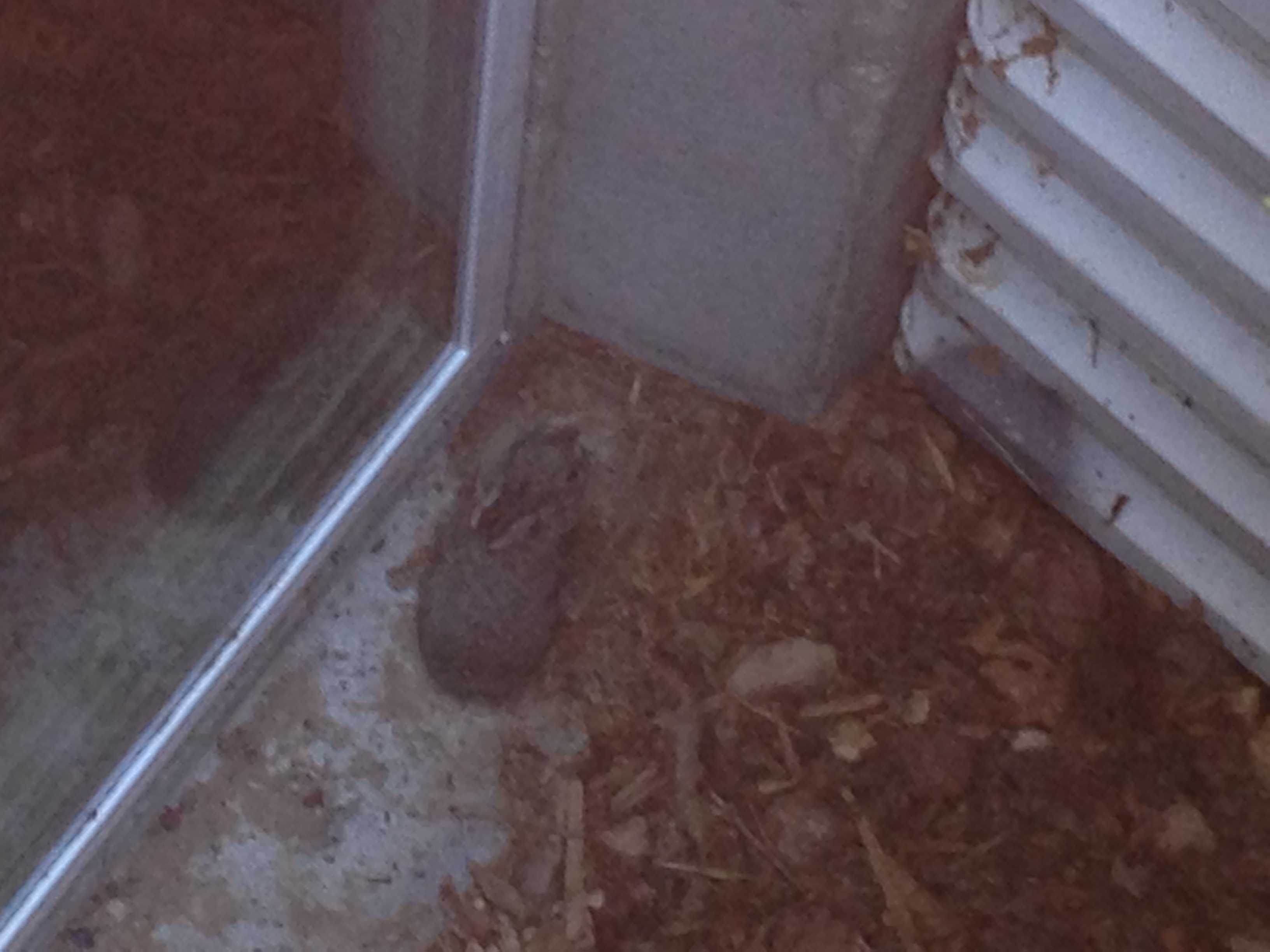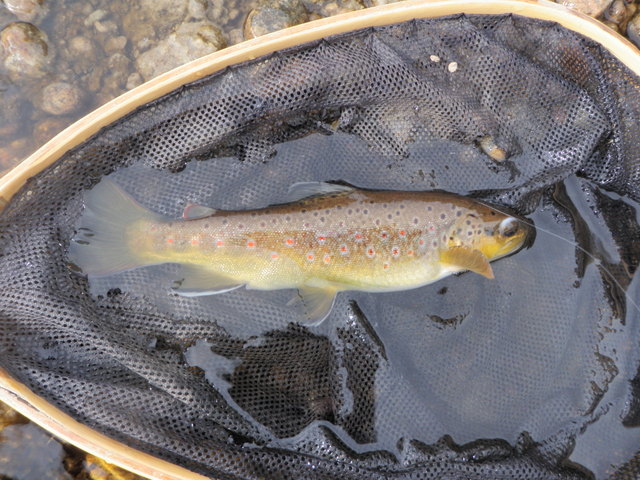Time: 12:00PM – 5:00PM
Location: Between Castle Rock campground and the next campground upstream
Fish Landed: 4 rainbows, 3 whitefish
Crooked River 06/19/2013 Photo Album
Having been skunked on the fabled Metolius River, I now felt a strong need to prove that I could catch at least one fish in the state of Oregon. I’ve proven that I can catch fish in Colorado, but what was it about Oregon that made me feel like a neophyte? Oregon streams can’t be any more difficult than Penns Creek or the South Platte River in Cheesman Canyon. As I reminisced I realized that I landed only a few small fish on the Clackamas River in 2011 and one on the Deschutes, albeit a steelhead. I had to go back to 2002, when I had some big days on rivers in the northeast corner of Oregon while returning Amy to Whitman College, to recall any degree of success.
Before leaving Amy’s house in Portland I printed a small brochure that listed fishing locations in Oregon with a small map. I began reading the brief descriptions of streams within a reasonable distance of the Metolius and settled on Crooked River near Prineville and the upper Deschutes River near Mt. Bachelor. The Deschutes in this area was described as a headwater with numerous brook trout, so this certainly sounded like an option where I could pad my numbers, but of course I was taking nothing for granted in Oregon. Crooked River was east of the Metolius and a tributary of the Deschutes and featured a 6-8 mile tailwater below the Prineville Dam where redband rainbow trout and whitefish were the predominant species. I liked the idea of catching native redbands, so chose this as my Wednesday destination.
I whined enough about getting skunked that I apparently convinced the rest of the campers that they needed to transport me to Crooked River and dump me off to get a break for their ears. Amy, Jane and Joe decided to spend the rest of the day hiking at Smith Rock State Park after depositing me by the river. The stretch of river I targeted was approximately 60 miles away, so it took over an hour of driving. The trip was at least quite scenic and the terrain changed from forests to green grassy flats with much agriculture including cattle and wheat fields.
We arrived at a wide pullout along the Crooked River at around noon and I grabbed all my gear and put on my waders and bid adieu to the others while descending a path to the river. I chose to stop in this area because I read the best fishing was between Castle Rock Campground and the dam and we’d just passed the campground. I observed numerous large exposed boulders in smooth pools linked by nice runs and pockets, and I usually prefer this type of water. It was a cool day with high temperatures projected in the sixties, and quite a few large gray clouds were visible in the western sky, so I wore my Adidas pullover and my raincoat over that.

Smooth Pool Downstream
Initially I walked downstream a bit and cut over to the river at the top of a long smooth pool where some nice runs and current entered. The clouds blocked the sun and almost immediately I noticed rising fish. I wasn’t seeing anything on the water, but several fish were definitely feeding on the suface, so I chose a CDC BWO. Overcast skies and small flies that are nearly invisible usually point to blue wing olives. Unfortunately that rule apparently doesn’t apply to Oregon as I received numerous refusals and no fish. After quite a bit of unproductive casting I decided to move on and leave the frustration behind and I convinced myself that the fish that were rising were quite small.
I moved upstream a bit to the nice runs and riffles and switched to a yellow Letort hopper with a beadhead hares ear; my typical beginning combination in Colorado. It didn’t take long before I hooked and landed a small whitefish and then a minnow sized rainbow that couldn’t have been more than two inches long. The day was beginning to play out similar to Tuesday on the Metolius.
Next I resorted to nymphing and added a thingamabobber along with a weighted 20 incher for weight and then an orange scud. A gentleman that I chatted with on the Metolius across from our campsite told me that scuds and San Juan worms are effective on Crooked River. He was apparently fishing a different section or different time of year because these flies were ignored so I switched the orange scud for a Craven BWO emerger. This finally did the trick and I hooked a rainbow that appeared to be around 10 inches, but as I played it, the fish dove into some heavy light green fibrous growth that was prevalent on the rocks of the Crooked River and got free. I was pretty frustrated at this point, as I still hadn’t landed a legitimate trout in Oregon on the trip.
I persisted and waded to the opposite side of the river thinking that few fishermen go to the trouble of doing this. In short order I approached a small island and began walking up the bank next to the smaller right channel. As I gazed up the smooth water, I spotted a rise. I’d seen a few caddis fluttering about and the rise was not a sipping rise like the ones observed in the pool at the start, so I elected to remove the nymphs and try a light gray size 16 caddis. On the third drift a rainbow knifed to the surface and gulped my caddis imitation, and I carefully played and landed a ten inch rainbow and photographed my achievement.

Finally an Oregon Rainbow
Perhaps I’d found the key on the Crooked River? I moved upstream a bit further and stumbled on the nicest stretch of water I would encounter on the day. A long riffle slid over moderate depth over the entire width of the river and fanned out into a deep long pool. I was stationed at the point where the riffle slowed down and dropped into the slower moving pool. Meanwhile some dark clouds once again moved above me and a brief shower ensued, and like clockwork fish began to rise directly across from me. Prior to the hatch I’d converted back to nymphs, and on one of my drifts about 10 feet across from me, a fish rose and inhaled the orange thingamabobber! I know for certain that it chomped on the orb because I instinctively set the hook and felt weight for a split second.
What did this mean? Was there a hatch of small orange balls commencing? I searched my fly boxes for an orange fly and spotted an orange Madam X that I’d tied quite a few years ago so I removed the nymph rig and tied on the Madam X. Sure enough after a few drifts a seven inch rainbow rose and sucked in the size 12 orange Madam X. Clearly I was overanalyzing Oregon fishing!
Unfortunately the number of fish rising increased, and they were ignoring the Madam X so I added a light gray comparadun trailing the Madam X. This was a nice setup for visibility and following my flies, but the fish were ignoring and the Madam X became waterlogged and began to sink. I clipped off the large attractor and used a single gray comparadun. This move elicited some refusals, but no takes, so I switched to a size 16 comparadun with a light yellow body that I’d tied for fishing to sulfurs in Pennsylvania. This did the trick one time and I landed another small rainbow, but then a string of refusals continued until the hatch ended when the sunshine returned.
I’d now landed three small rainbows, and the rising fish at least gave me optimism. I continued upstream past another campground and a huge long slow moving pool to an island above the pool. Near the top of the pool I spotted a few sporadic rises and climbed down close the water to make some half hearted casts, but this did not produce. I was now searching for an exit strategy, in other words a place to cross back to the road and return to the pullout where I was scheduled to meet my transportation. I scouted the other side of the island and determined that I could wade to the island at the bottom end and then walk up the island to the top where I could cross the opposite channel. After executing this maneuver I hiked down the road toward the meeting place pullout.
As I moved to the lower end of the long pool I noticed a couple strolling along the river bank and then I heard the woman began to screech something in a high pitched voice. A minute or two later I noticed a young dog on the opposite side of the river in the very spot where I’d landed two rainbows, and the spaniel or pointer appeared to be upset and unable to cross back to the side of the river of the approoaching owners. The woman yelled up to me and asked if there was a place to cross and I suggested the island above the long pool.
I moved on and arrived at the meeting point slightly before 5PM, so I decided to return to the river by the pullout and fish until Amy, Jane and Joe arrived. I could see the arrival of any cars above me. I tied on a Chernobyl ant with a pink foam indicator, but the fly kept landing on the wrong side, so I swapped it for a yellow Chernobyl and beneath that attached a headhead hares ear. I began fishing, but before long I heard a car door slam, and then looked upstream to see the male portion of the couple with the dog. Apparently the boyfriend volunteered or was ordered to save the dog, and the young man was looking for a place to cross. I suggested the island to him, but also mentioned that I’d crossed somewhere between his current location and the long pool. I suggested that he obtain a strong stick before he made the attempt.

A Ten Inch Rainbow with Streamside Mint from Crooked River
I refocused on my fishing and began prospecting the Chernobyl and BHHE, and eventually hooked and landed and photographed a ten inch rainbow that hit the BHHE on a swing in front of a large rock. In addition I landed another whitefish just before my family arrived and picked my up for the return trip.
Like this:
Like Loading...






























